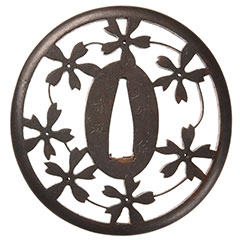
保存刀装具 Hozon Tousougu
在銘 赤坂 忠時作鍔/鐔Zaimei Akasaka Tadatoki-saku Tsuba
No.013410在銘 武州住 赤坂 忠時作桜花繋透鍔Zaimei Busyu jyu Akasaka Tadatoki-saku Ouka-Tsunagi-Sukashi Tsuba
ご成約Sold
- 銘表Mei-Omote
- 武州住 赤坂武州住 赤坂 Busyu jyu Akasaka
- 裏銘Ura-mei
- 忠時作忠時作 Tadatoki-saku
- 時代Period
- 江戸時代Edo period
- 法量Size
-
縦 8.00cm 横 7.69cm 切羽台 0.52cm 中心孔縦 2.63cm 中心孔横 0.62cm 重量 101.00g
Length 8.00cm Width 7.69cm Seppadai 0.52cm Nakaoana-Length 2.63cm Nakaoana-Width 0.62cm Weight 101.00g
- 説明Drscription
- 竪丸形 鉄地 地透 丸耳
赤坂派の初代・二代の忠正親子が江戸へ寛永頃移住し、尾張透の手法と京透の工法に工夫を加えて鐔を制作し、幕末頃まで栄えた。初・二・三代(古赤坂)は、鉄地の鍛が良好で造形は丸形、丸耳で厚手のものが多く、角丸風造りも見られる。四代目忠時の頃から鐔もやや薄くなり、精巧な造込となった。赤坂という呼称はこの一門の職人たちの居住地(現在の東京都港区の赤坂一帯)から用いられた。
赤坂派 忠時 彦十郎は、赤坂派の初代忠正から4代目に相当するが、在銘赤坂派の初代であり、以後9代まで忠時を名のった。
宝永4年(1707年)3代目正虎の跡を受け39年間在職。晩年は家督を二代忠時に譲り、忠宗と称した。延享3年(1746年)没する。
作風は、初代忠正の頃から比べるとやや薄くなり精巧な造り込みとなった。鉄地丸形に社頭、桐、薄、茶筌、末広、茗荷などの図案風な地透鍔を造る。Tatemarugata Tetsuji Jisukashi Marumimi
The first and second generations of the Akasaka school, Tadamasa and his son, moved to Edo around the Kan'ei era, where they produced tsuba by adding ingenuity to the Owari-tou method and the Kyo-tou method, and prospered until the end of the Edo period. The 1st, 2nd and 3rd generation (Ko-Akasaka) have good forging of the iron base, and many of them are round and thick with round ears. From around the time of Tadatsuki IV, the tsuba became a little thinner and became more elaborately crafted. The name Akasaka was used from the place where the craftsmen of this family lived (present-day Akasaka area in Minato Ward, Tokyo).
Akasaka School Tadatoki Hikojuro is the fourth generation from the Akasaka School's first generation Tadamasa, but he was the first generation of the Akasaka School to have a name, and from then on, the name Tadatoki was used until the ninth generation.
In 1707, he succeeded the third Masatora and served for 39 years. In his later years, he handed over the headship of his family to the second generation Tadatoki, who took the name Tadamune. He died in 1746.His style has become somewhat thinner and more elaborate than that of Tadamasa first.He makes Ji-Sukashi-Tsuba with designs such as Syatou, paulownia, thin, Chasen, Suehiro, and Myoga in Tetsuji Marugata.


